The Customer Acquisition Slide
Our Customer Acquisition Slide in our pitch deck details our acquisition strategy for new customers. For many startups, defining a marketing growth strategy will be inherently linked to our customer acquisition cost for new customers and the key metrics in how we convert them.
August 19th, 2022 | By: The Startups Team | Tags: Customer Acquisition
Continuing in Phase Three of a four-part Funding Series:
Phase One - Structuring a Fundraise
Phase Two - Investor Selection
Phase Three - The Pitch
Part 1 - Anatomy of a Pitch
Part 2 - Market Size
Part 3 - Revenue Model
Part 4 - Operating Model
Part 5 - Customer Definition
Part 6 - Customer Acquisition (←YOU ARE HERE 😀)
Part 7 - Funding
Part 8 - Key Pitch Assets
Part 9 - Traction
Phase Four - Investor Outreach
Let’s dive in!
Our Customer Acquisition Slide in our pitch deck details our acquisition strategy for new customers. For many startups, defining a marketing growth strategy will be inherently linked to our customer acquisition cost for new customers and the key metrics in how we convert them.
What does a Customer Acquisition Strategy look like?
Our Customer Acquisition Strategy will be composed of 4 elements:
Define Acquisition Channels
Cost Assumptions (of each channel)
Conversion Metrics
Customer Acquisition Costs
Let's walk through each of these elements and how they fit into the customer acquisition slide.
Define Acquisition Channels
Every customer acquisition strategy in a pitch deck is a culmination of a number of marketing channel decisions. We tend to acquire customers through multiple channels and therefore, our customer acquisition process needs to highlight which we'll use, without going into extraordinary detail.
Most Popular Customer Acquisition Channels
Direct Sales
Online Acquisition (Paid Ads, Organic SEO, Social, Email)
Offline Acquisition (Newspaper, TV, Radio, Mail)
Partner Marketing (Retailers, Resellers, Affiliates)
Word of Mouth Marketing
Direct Sales
Direct Sales is a customer acquisition strategy that involves customers bypassing traditional customer acquisition methods and buying directly from our sales team or "store". This lead generation strategy assumes existing customers or new customers are purchasing without any associated acquisition cost.
For the purposes of our pitch deck, our demand creation strategy only needs to highlight what percentage of our target prospects will be coming directly, as there is no hard cost associated. This may require a bit more explanation of our sales funnel and our approach to sales force automation if we're employing a sales team directly.
Online Acquisition Strategy
These days most customer acquisition costs tend to be online and therefore this slide of our pitch deck tends to be heavily centered there. Since online marketing campaigns now have very specific domains that can all scale significantly we may find ourselves breaking this category into important subcategories for more clarity of the customer lifecycle.
Search Engine Optimization (SEO)
Our content strategy (blog post cadence and content creation strategy) will likely go hand in hand with our overall SEO strategy. We'll want to highlight where we think SEO fits in our overall marketing funnel in our customer acquisition slide.
If SEO is important to our customer acquisition strategy then the customer acquisition slide doesn't need to go into a ton of detail, it just needs to highlight the percentage of our traffic or sales that will stem from it. If investors really care, they'll dig deep into our demand creation strategy in every aspect, so we don't need to go into exhaustive detail in the pitch deck itself.
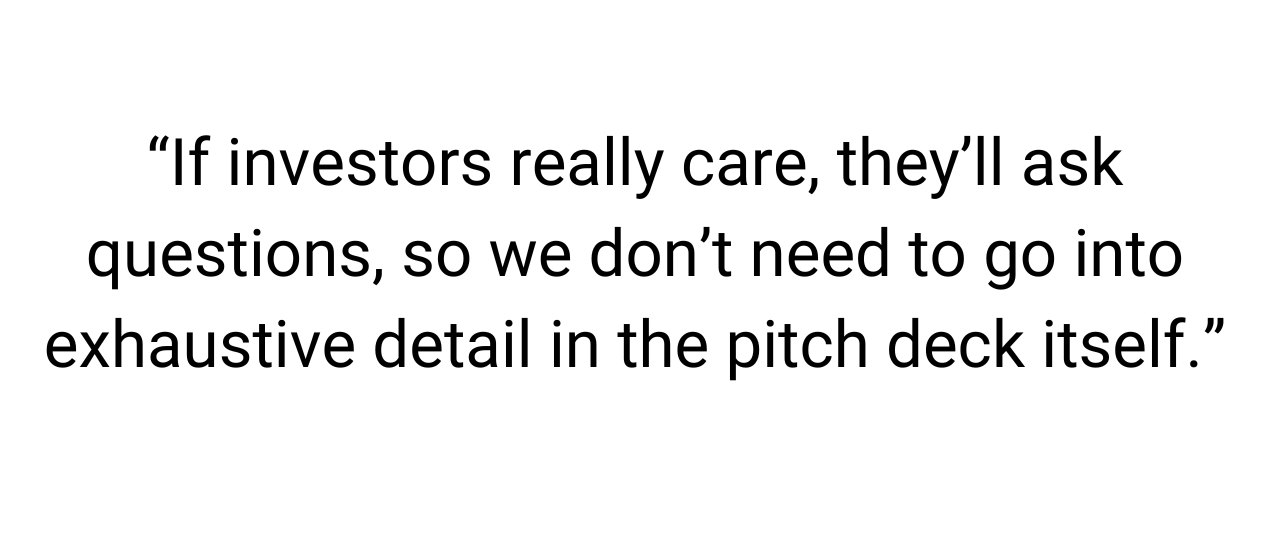
Pay Per Click Ads
One of the most common early-stage marketing tactics to kick start growth is pay-per-click ads (typically Google and Facebook). Long before we can rely on repeat customers and customer retention we need to spend a little bit of money on new customers via pay-per-click.
At this stage of the pitch deck, we just need to illustrate where we think pay-per-click fits in our customer acquisition framework. We're largely estimating now, but once we get some marketing automation setup and begin a true lead nurturing lifecycle we'll be able to provide (and update) better information in our customer acquisition slide.
For now, let's just use a placeholder if we think this tactic is important with the expectation that we'll update input variables (assumptions) as we go.
Social Media Marketing
Most startups will tell their marketing team to kick start their brand awareness with social media because it's easy to get started. We sometimes misrepresent this in our customer acquisition slide as being a "free" way to acquire customers, and while it can be, it rarely is.
Social media may be free to start, but there is often a cost associated with it that we will blend into our overall Customer Acquisition Cost (CAC). Whether that's the cost of the marketing team (if we have one) or if we're paying for the items in our content strategy all of these costs should be accounted for in our pitch deck.
Email Marketing
Every email is marketing, whether it's the outbound emails we load into our sales force automation or the responses from our customer success team. New customers can be founders anywhere and our interactive email marketing campaigns need to account for this.
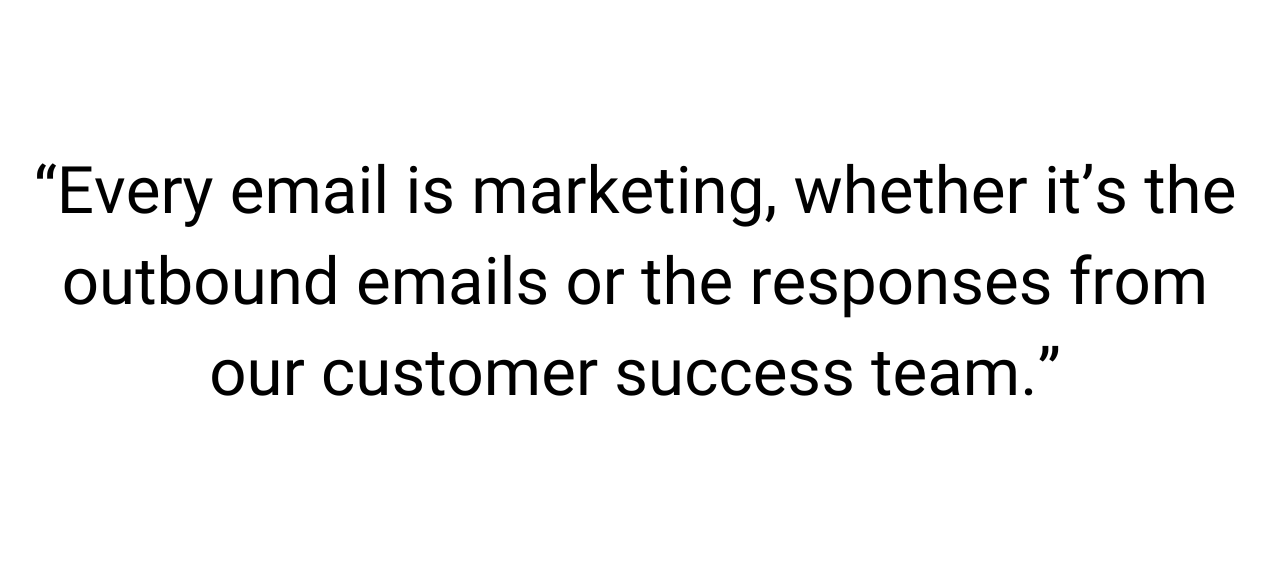
The email usually ties into our customer loyalty lifecycle because it's the most common way we are interacting with qualified leads. Investors just need to know how email fits into our marketing roadmap with our other channels.
Combining Online Channels
As we discussed most startups have a combination of online marketing campaigns that form a single strategy. Our customer acquisition slide just highlights where and how they come together and will ultimately help support our estimates of our customer acquisition costs.
If you're not quite sure how you'll use these channels to increase market size just yet — don't worry. It's OK to just pick the online marketing channel or two that you think might be effective and come back to it later.
Offline Acquisition
Depending on the business model of your company, you may go beyond digital assets into physical ones. Offline customer acquisition has built countless large brands and there is certainly room for it in your pitch deck if you think it will be effective to acquire customers.
If our customer acquisition plan is going to be localized, we'll want to play on local channels for newspaper, TV, radio, and direct mail. We may find that lead management is more effective when we're only focused on a particular local segment of our market expansion versus a "spray and pray" national approach.
Channel Partners
Our lead generation strategy for channel partners will involve everything from traditional channels like retail partners to affiliate partners. We have to think of each channel as a new customer to be acquired, so when we present this customer acquisition strategy to investors they are going to want to know how we will scale this.
Our customer acquisition slide therefore may be split between "How we acquire channel partners" and "How we are sent referrals as new customers." There is a distinct process and outcome for each that we'll want to follow.
Word of Mouth Marketing
Word of Mouth marketing can take on many forms, from basic referral revenue schemes to contests to loyalty programs. What matters most is creating enough activated users that we begin to get the flywheel going.
Our pitch deck needs to explain how we are going to get these flywheels going. Again, we don't need a ton of detail, we just need an overview of how we will initiate and develop these programs over time.
Cost Assumptions per Channel
Now things get interesting. Let's say you suggested you were going to use Social Media as a primary tactic to find customers. You now need to begin identifying what your costs would be for leveraging that acquisition channel so that you can start to distill how much each acquired customer will cost (we'll do that in a moment).
No Such Thing as "Free Acquisition Cost"
While the Interwebz may offer what seems like a free channel platform, there are almost always real costs to using it well. Your social media likely going to require you to author lots of content to be shared with prospective customers. That costs money.
You will likely need to pay to promote some of your content on Facebook and Twitter until you've built up a following. That costs money. You may not be able to manage the campaigns yourself and have to outsource the work to a consultant. Yes, you got it — money.
Building a Budget for "Free" Costs
Your job here is to forecast and compile all of the associated costs with a particular channel so that you can arrive at a preliminary budget for what it would cost to use this channel. Sorry If you're not sure of what your budget should be, ask yourself what the least amount of capital would be to get started, and then start figuring out which costs would escalate over time.
This should leave you with a nice little "cost per channel" which scales based on activity. In order to know how you can scale those costs, though, you'll need to have an idea of how effective those channels will be.
Conversion Metrics
You can easily assign a budget for what you want to spend on a marketing channel, but until you know how effective that channel might be, the budget is just a big guess. What you really want to determine is at what rate your marketing spend converts to actual customers.
Example - Conversion of a Lead
If 1,000 people visit your Web site and 50 of them become a "lead," your rate of conversion to a Lead is 5%"
How do We Create Our Estimates?
An easy way to create estimates to pick a goal for how much revenue we want to achieve, and then determine what other assumptions would have to hold true to get there.
Example — Estimating for Revenue
If we want to make $1,000 in Revenue, and our product price is $20, then we need 50 sales to reach that goal.
Therefore if we start with 1,000 Web site visitors, we can estimate that if 5% purchase (Conversion Rate) that will generate 50 sales.
Our Conversion Rate is 5%.
There are a handful of common key metrics marketers use and investors expect to see in a pitch deck — some of which may not apply to your situation.
Marketers can get pretty complex with how many conversion rates they track and other metrics. You can be as complex as you'd like, but you're going to at least need to provide some basic metrics for things like acquiring a lead (which can mean someone submitting their email address) or acquiring a sale.
Your conversion metrics will typically drive your budgets accordingly. You will spend a small amount of money to begin learning how your metrics work and then as you learn more and are able to make your metrics work profitably (your cost of acquiring a paid customer is less than what they pay you) you can begin scaling the budget accordingly.
Customer Acquisition Costs
Early on you're likely going to be making educated estimates around what your conversion metrics will be.
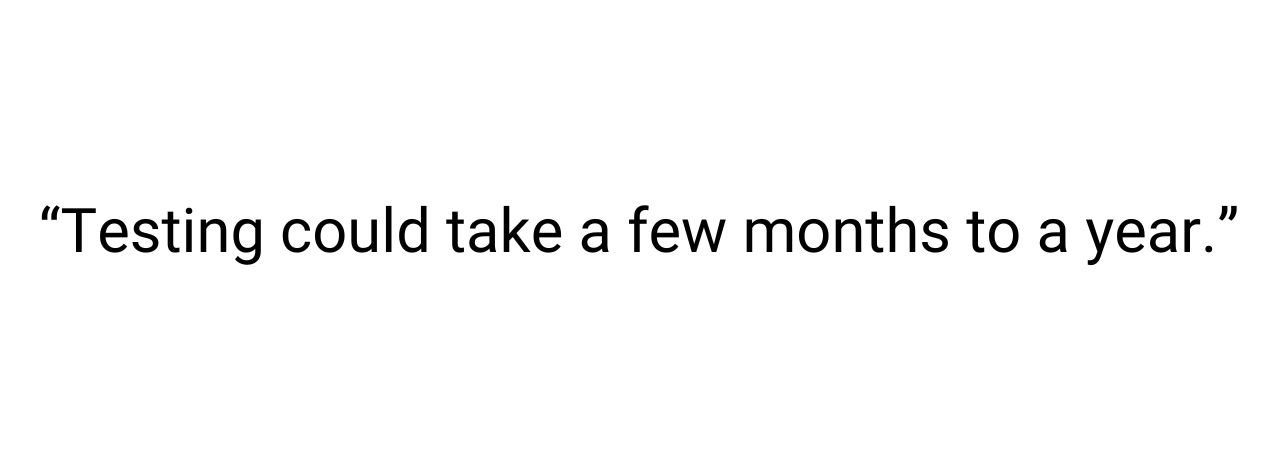
A good rule is to assume your spend will be modest initially and likely won't have positive outcomes until you start to figure out what channels work. Testing could take a few months to a year. It's sometimes a little difficult to show "negative metrics" in your forecasts without having a little narrative description of why these are what they are. You can solve for this by putting small comments in the cells of the spreadsheet where your economics change as well as providing some narrative descriptions with your forecasts to explain where and how your numbers change over time.
Example
"In Year 1 we're estimating our Cost per Sale will be $140 even though the average sale is only $20. Most of this delta will be the cost of us experimenting with many channels to find the right mix of profitable spending. We will then scale in Year 2 with a more optimized spend, targeting a Cost per Sale of $15. We can do this by simply eliminating poorly performing channels."
No one expects you to have all the answers immediately, so focus on explaining your approach to finding the answers. Recognize that spending time and money to calibrate your marketing spend is a very reasonable approach that investors should definitely appreciate.
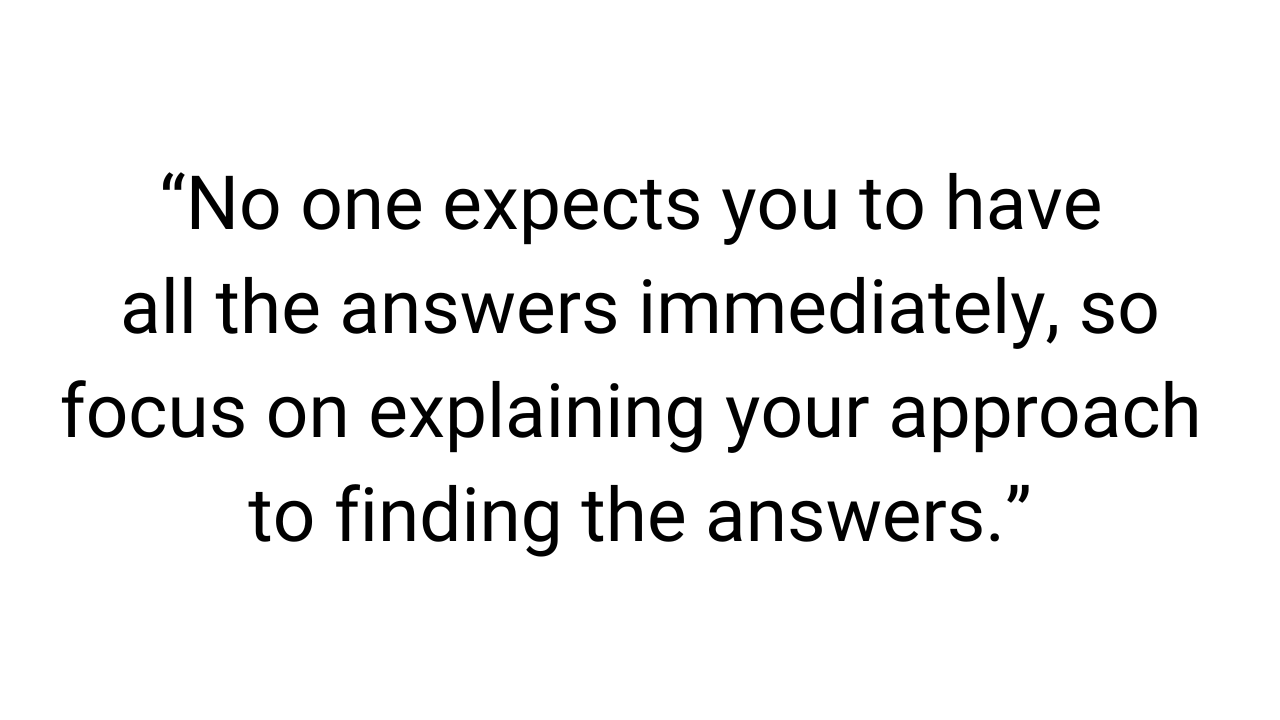
Customer Acquisition is a Popular Discussion
Any remotely savvy investor who is interested in the solution you've created is going to "lean in" when it comes time talk about customer acquisition. That's because great products with horrible customer acquisition strategies often die on the vine. Even an inferior product that has a powerful customer acquisition strategy (read: any product you see on late-night TV) can be turned into a big business.
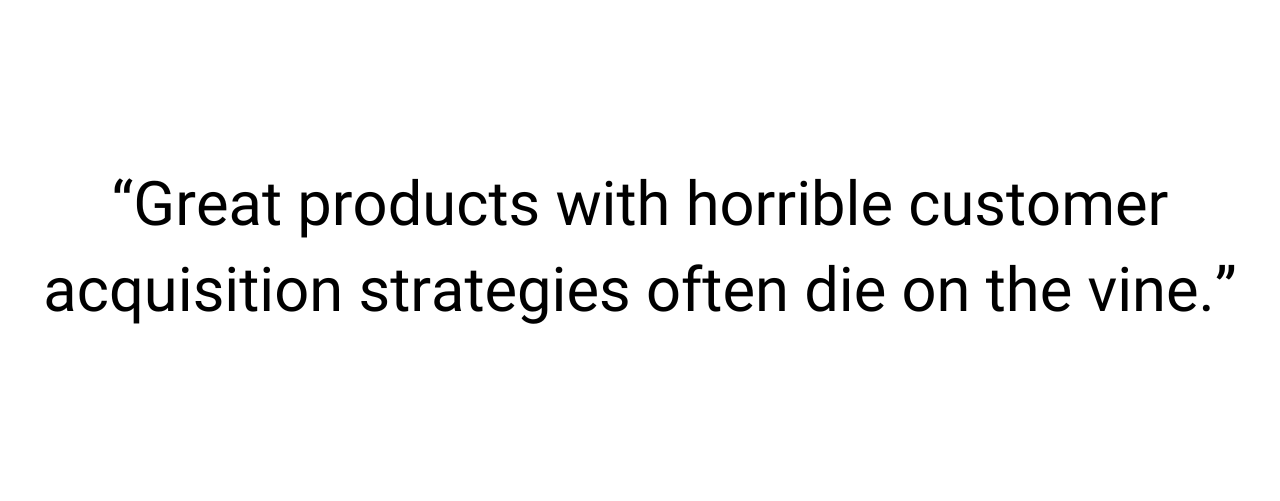
You may not have many of the exact answers at this stage of your business, but it's certainly your job to explore each of the major customer acquisition channels and provide some insights as to which ones you think will be the most effective and why. Once again, you're being evaluated on your ability to assess opportunists and think about them rationally. Your approach to customer acquisition is a reflection of this assessment.
Continue to Part 7 - Funding
About the Author
The Startups Team
Startups is the world's largest startup platform, helping over 1 million startup companies find customers, funding, mentors, and world-class education.
Related Articles
Unlock Startups Unlimited
Access 20,000+ Startup Experts, 650+ masterclass videos, 1,000+ in-depth guides, and all the software tools you need to launch and grow quickly.
Already a member? Sign in